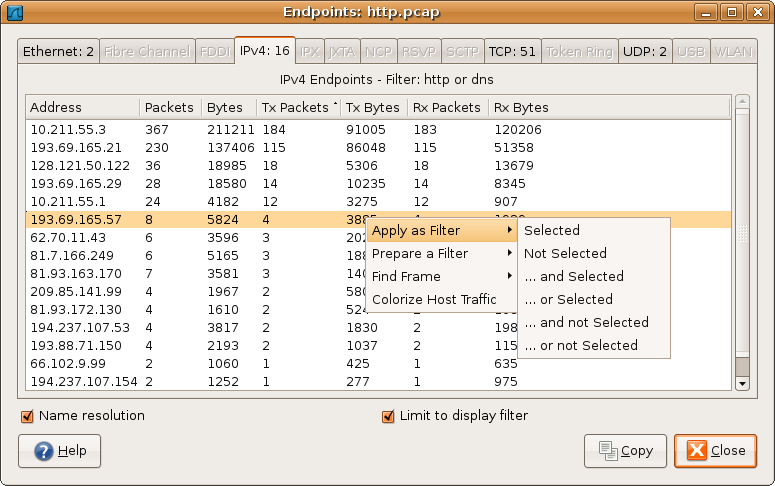Statistics of the endpoints captured.
![[Tip]](tip.png)
|
Tip! |
|---|---|
|
If you are looking for a feature other network tools call a hostlist, here is the right place to look. The list of Ethernet or IP endpoints is usually what you're looking for. |
A network endpoint is the logical endpoint of separate protocol traffic of a specific protocol layer. The endpoint statistics of Wireshark will take the following endpoints into account:
-
Ethernet: an Ethernet endpoint is identical to the Ethernet's MAC address.
-
Fibre Channel: XXX - insert info here.
-
FDDI: a FDDI endpoint is identical to the FDDI MAC address.
-
IPv4: an IP endpoint is identical to its IP address.
-
IPX: an IPX endpoint is concatenation of a 32 bit network number and 48 bit node address, be default the Ethernets' MAC address.
-
JXTA: a JXTA endpoint is a 160 bit SHA-1 URN.
-
NCP: XXX - insert info here.
-
RSVP: XXX - insert info here.
-
SCTP: a SCTP endpoint is a combination of the host IP addresses (plural) and the SCTP port used. So different SCTP ports on the same IP address are different SCTP endpoints, but the same SCTP port on different IP addresses of the same host are still the same endpoint.
-
TCP: a TCP endpoint is a combination of the IP address and the TCP port used, so different TCP ports on the same IP address are different TCP endpoints.
-
Token Ring: a Token Ring endpoint is identical to the Token Ring MAC address.
-
UDP: a UDP endpoint is a combination of the IP address and the UDP port used, so different UDP ports on the same IP address are different UDP endpoints.
-
USB: XXX - insert info here.
-
WLAN: XXX - insert info here.
![[Note]](note.png)
|
Broadcast / multicast endpoints |
|---|---|
|
Broadcast / multicast traffic will be shown separately as additional endpoints. Of course, as these endpoints are virtual endpoints, the real traffic will be received by all (multicast: some) of the listed unicast endpoints. |
This window shows statistics about the endpoints captured.
For each supported protocol, a tab is shown in this window. Each tab label shows the number of endpoints captured (e.g. the tab label "Ethernet: 5" tells you that five ethernet endpoints have been captured). If no endpoints of a specific protocol were captured, the tab label will be greyed out (although the related page can still be selected).
Each row in the list shows the statistical values for exactly one endpoint.
Name resolution will be done if selected in the window and if it is active for the specific protocol layer (MAC layer for the selected Ethernet endpoints page). As you might have noticed, the first row has a name resolution of the first three bytes "Netgear", the second row's address was resolved to an IP address (using ARP) and the third was resolved to a broadcast (unresolved this would still be: ff:ff:ff:ff:ff:ff); the last two Ethernet addresses remain unresolved.
Limit to display filter will only show conversations matching the current display filter.
The copy button will copy the list values to the clipboard in CSV (Comma Separated Values) format.
![[Tip]](tip.png)
|
Tip! |
|---|---|
|
This window will be updated frequently, so it will be useful, even if you open it before (or while) you are doing a live capture. |
Before the combined window described above was available, each of its pages was shown as a separate window. Even though the combined window is much more convenient to use, these separate windows are still available. The main reason is that they might process faster for very large capture files. However, as the functionality is exactly the same as in the combined window, they won't be discussed in detail here.
